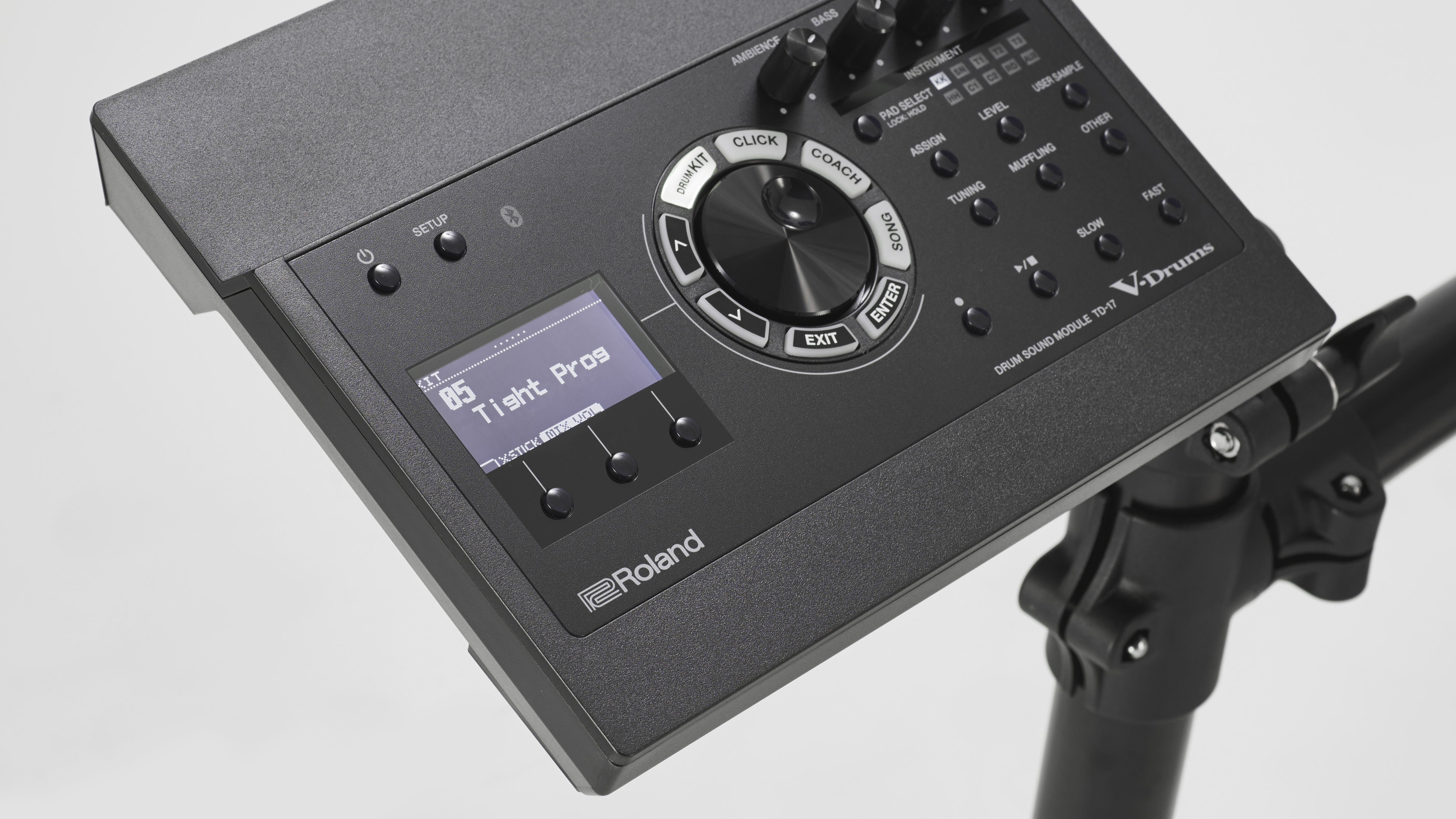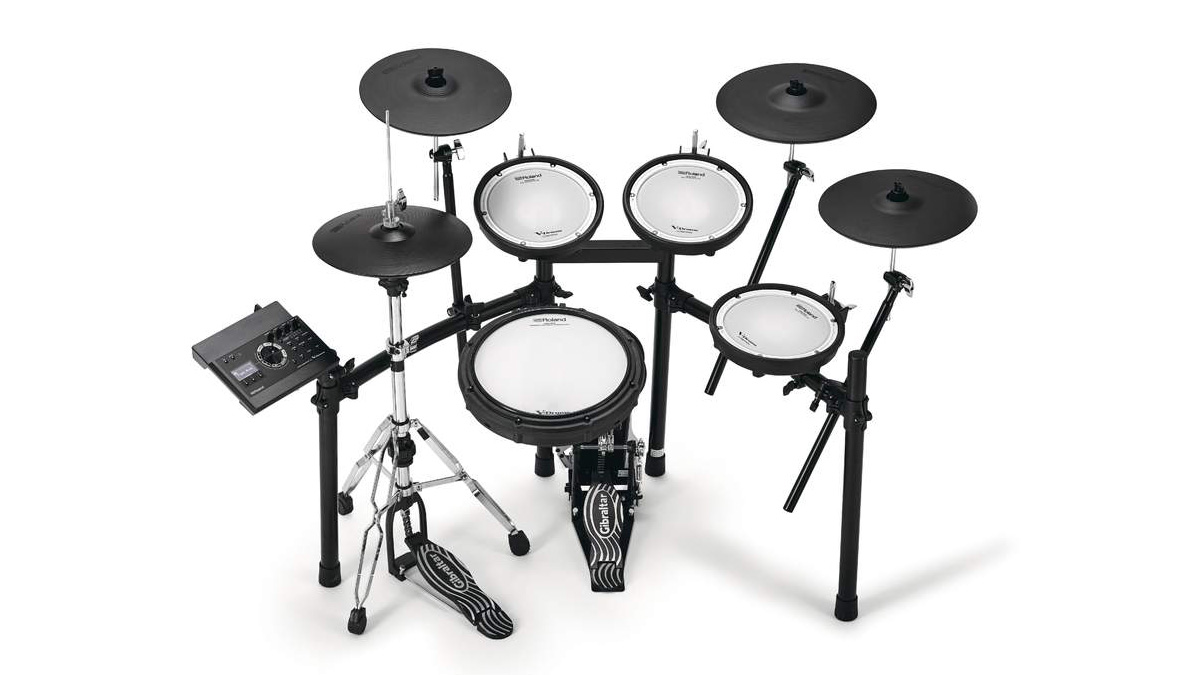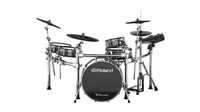MusicRadar Verdict
It might be an entry-level kit but the reward is a level of sound quality, and an array of features and great playability that raises the standard with a set of mid-priced V-Drums that are serious and grown-up.
Pros
- +
Simply superb build and sounds.
- +
Not cheap but excellent value.
- +
Upload your own samples.
- +
Newly-designed PDX-12 snare pad offers more acoustic feel.
Cons
- -
Virtually impossible to fault.
MusicRadar's got your back
When Roland turns its full attention on its electronic drum kit lineup it's time to pay attention, and the TD-17 series is case in point. It's a ‘midrange’ kit that might not be super-cheap, but in the value-for-money stakes, it's a serious contender.
It’s comes in three configurations and features some all-new pad designs, sounds culled from Roland's superb flagship module, the TD-50, as well as bringing onboard some Bluetooth connectivity and the ability to import your own samples.
‘We design the future’ is the Roland mantra, and it is no exaggeration to say that its V-drums lineup and this design ethos has shaped the way we drummers think about electronic kits. Roland has taken them from the stuff of confusion and discomfort to everyday solutions for practising, production and performance.
The whole idea behind the TD-17 is that an electronic set shouldn’t feel like a compromise. Practicality and performance could be delivered in one product. Roland’s ‘Become a better drummer, faster’ was not just marketing spin; it was the idea behind the instruments.
Just look at the module and pad updates; they offer all the playability, sound quality and functionality we’ve come to expect from Roland with a comprehensive spec sheet.
- Check out the best Roland electronic drum sets for all abilities
- Want some other options? Here are the best Yamaha e-kits
Build
Here we are looking at the full TD-17 lineup for review. Everything you see pictured is the full suite of updated physical kit.
There is the all-mesh PDX-8 tom pads all-round, plus a pair of CY-12C crash cymbal pads – and a CY-13R ride pad. Elsewhere there is the newly-designed PDX-12 snare pad, offering a more generous 12" playing surface than the PDX-8 (which is really a 10" pad), plus it has a raised rim designed to offer a more ‘acoustic’ feel.
Want all the hottest music and gear news, reviews, deals, features and more, direct to your inbox? Sign up here.
Next up we've got the 12" VH-10 hi-hat. This is a single-pad design that continues Roland’s legacy of stand-mounted hat pads. The new KD-10 bass drum pad promises to make less noise acoustically than the previous KD-9. And, if all that that wasn’t enough numbers and initials, keep in mind that there are two other configurations.

The TD-17L is the entry level configuration and it forgoes the pad updates, including only a mesh snare. Note: all the tom pads are rubber PD-8As, while the hi-hats are the CY-5 model. What you are really getting here is the module, complete with its trickle-down from the TD-50, but Roland has also left the Bluetooth connectivity off the TD-17L (TD-17K-L, priced at £879).
In between this entry level model and our top-of-the-range review model comes the TD-17KV (£1,229). Now, this uses the same CY-8 and CY-5 cymbal/hi-hat pads as the entry-level kit, but for a few dollars more you get the updated snare pad, the same mesh toms as our review kit, and Bluetooth functionality.
Now, with all the introductions out of the way, how does the TD-17 set actually perform?
Hands on
Building the rack system is the first and unquestionably the worst part of setting up an electronic kit. Sadly, this never becomes any more fun over time, but just think, once you are done, that's it. It's pretty much ‘set and forget’. We found the rack system sturdy and all the required cables are provided on a loom, each labelled and colour-coded, taking some of the pain out of the process of plugging them all in.
Let's look at the module. In recent years, Roland has went against the grain of more-is-better when it comes to the number of voices within its drum brains.
The idea is sound: many drummers discover a handful of favourite preset kits and sounds, and choose to jump between them rather than requiring hundreds of additional sounds that they won’t use.
We like Roland's confidence. Despite a little initial scepticism, it seems to work in practice; flicking through the sounds we’re struck by their quality. Better still, with Roland’s processing, we are offered plenty of tweak-ability to these base sounds.

The TD-17 module is immaculate and clean. Yes, we did find the screen/buttons combo a little bit fiddly but there are also plenty of things that have been simplified – particularly if you’re au fait with Roland's menu terminology and systems.
The module is is scarily intuitive. We didn’t even have to reach for a manual when selecting a voice and making tonal changes. It's all laid out and labelled very clearly. There is no shortage of dedicated switches for common functions such as tuning, muffling, ambience, EQ and volume levels. Acquaint yourself with the cursor/enter buttons and you’ll be flying in no time.
The addition of Bluetooth is big news, as is the ability to import your own samples to play directly from the pad. Give that this sample loading is something that Roland has explored comprehensively in its hybrid line-up, it is a surprise that it has taken this long to show up here.
Flicking through the sounds we’re struck by their quality. Better still, with Roland’s processing, we are offered plenty of tweak-ability to these base sounds
The official company line is that it was waiting for the hardware to be up to snuff with regards latency issues, but in our Alesis Command Mesh review, the opposition have already been doing this with no issues.
Either way, we’re glad, because Roland's way of organising things makes everything involved with loading samples into the TD-17 undeniably easier. You can throw whatever wav sample you have on file onto an SD card and load it up on the TD-17’s pool of 100 user sound slots – 16-bit, stereo or mono.
From there on, just assign it in the same way as you would any other sound – hit the pad and then scroll on through. Next up is the Bluetooth. Many companies have created their own systems that allow you to jam with your music collection through your app of choice but Roland's solution is undoubtedly the best.
Pairing the devices with our Spotify account to play along was fast and without fault, and it was rock solid in performance – plus you've got the added bonus of Roland’s tray design on the module for safe-storage of your phone as you jam. It's the little things... Ultimately, you want all these features to be supporting your playing, not getting in the way, and that's just how it is with the TD-17.
MusicRadar verdict: It might be an entry-level kit but the reward is a level of sound quality, and an array of features and great playability that raises the standard with a set of mid-priced V-Drums that are serious and grown-up.
Undecided?
Check out the best electronic drum sets for every budget
Whether you're after a cheap electronic drum kit for beginners, a mid-range set for home practice or something for gigging and professional session recording, here’s our pick of the very best electronic drum kits for all levels of player.

Stuart has been working for guitar publications since 2008, beginning his career as Reviews Editor for Total Guitar before becoming Editor for six years. During this time, he and the team brought the magazine into the modern age with digital editions, a Youtube channel and the Apple chart-bothering Total Guitar Podcast. Stuart has also served as a freelance writer for Guitar World, Guitarist and MusicRadar reviewing hundreds of products spanning everything from acoustic guitars to valve amps, modelers and plugins. When not spouting his opinions on the best new gear, Stuart has been reminded on many occasions that the 'never meet your heroes' rule is entirely wrong, clocking-up interviews with the likes of Eddie Van Halen, Foo Fighters, Green Day and many, many more.

